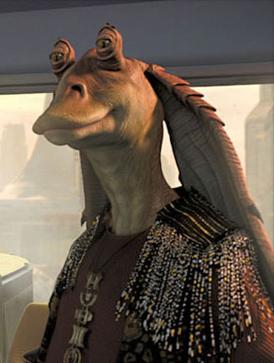
Jar Jar Binks is a fictional character of the Gungan race from the Star Wars saga created by George Lucas. Jar Jar appears throughout the Star Wars prequel trilogy – as a major character in Episode I: The Phantom Menace and with a supporting role in Episode II: Attack of the Clones and Episode III: Revenge of the Sith – as well as having a role in the television series Star Wars: The Clone Wars. The first fully computer-generated supporting character in a live-action film, he has been voiced by Ahmed Best in most of his appearances, who also acted out the character with prosthetics prior to the CGI work. The last mention of Binks is in the 2017 canonical novel Aftermath: Empire's End.

Star Wars: Episode I – The Phantom Menace is a 1999 American epic space opera film written and directed by George Lucas. It stars Liam Neeson, Ewan McGregor, Natalie Portman, Jake Lloyd, Ahmed Best, Ian McDiarmid, Anthony Daniels, Kenny Baker, Pernilla August and Frank Oz. It is the fourth film in the Star Wars film series, the first film of the prequel trilogy and the first chronological chapter of the "Skywalker Saga". Set 32 years before the original trilogy, during the era of the Galactic Republic, the plot follows Jedi Master Qui-Gon Jinn and his apprentice Obi-Wan Kenobi as they try to protect Queen Padmé Amidala of Naboo in hopes of securing a peaceful end to an interplanetary trade dispute. Joined by Anakin Skywalker—a young slave with unusually strong natural powers of the Force—they simultaneously contend with the mysterious return of the Sith. The film was produced by Lucasfilm and distributed by 20th Century Fox.
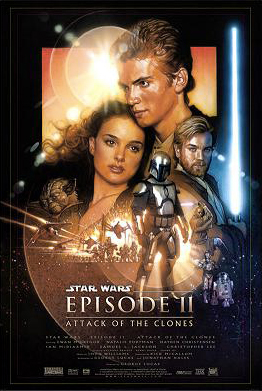
Star Wars: Episode II – Attack of the Clones is a 2002 American epic space opera film directed by George Lucas and written by Lucas and Jonathan Hales. The sequel to The Phantom Menace (1999), it is the fifth film in the Star Wars film series and second chronological chapter of the "Skywalker Saga". The film stars Ewan McGregor, Natalie Portman, Hayden Christensen, Ian McDiarmid, Samuel L. Jackson, Christopher Lee, Anthony Daniels, Kenny Baker, and Frank Oz.
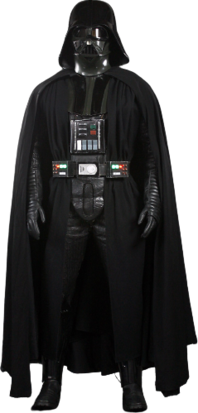
Darth Vader is a character in the Star Wars franchise. He is the primary antagonist of the original film trilogy and, as Anakin Skywalker, is the protagonist of the prequel trilogy. Born a slave on the planet Tatooine, he becomes a powerful Jedi. He is lured to the dark side of the Force by Chancellor Palpatine, and becomes the Sith Lord Darth Vader. After being severely wounded in a lightsaber battle, he is transformed into a cyborg. He is the husband of Padmé Amidala and the biological father of Luke Skywalker and Leia Organa Solo.
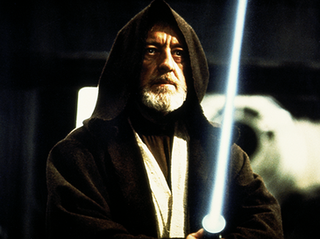
Obi-Wan Kenobi is a fictional character in the Star Wars franchise. Within the original trilogy, Obi-Wan is a Jedi Master as a supporting character and is portrayed by English actor Alec Guinness. In the later-released prequel trilogy, a younger version of the character serves as one of the two main protagonists, alongside Anakin Skywalker, and is portrayed by Scottish actor Ewan McGregor. In the original trilogy he is introduced as Ben Kenobi, an alias he uses while in hiding from the Empire. He is a mentor to Luke Skywalker, to whom he introduces the ways of the Jedi. After sacrificing himself in a duel against Darth Vader, Obi-Wan guides Luke through the Force in his fight against the Galactic Empire. In the prequel trilogy, set two decades earlier, he is initially a Padawan (apprentice) to Jedi Master Qui-Gon Jinn, and later mentor and friend of Luke's father Anakin, who falls to the dark side of the Force and becomes Vader. The character briefly appears in the sequel trilogy as a disembodied voice, speaking to protagonist Rey, and serving as the namesake of Ben Solo. He is frequently featured as a main character in various other Star Wars media, including the streaming television miniseries Obi-Wan Kenobi, in which McGregor reprised the role.

Qui-Gon Jinn is a fictional character in the Star Wars franchise, played by Liam Neeson. He is a main character in the prequel film trilogy, serving as one of the protagonists of The Phantom Menace (1999). He appears briefly as a Force ghost in the 2008 animated series The Clone Wars, the season finale of the 2022 live-action series Obi-Wan Kenobi, along with Attack of the Clones and The Rise of Skywalker as a disembodied voice, with Neeson reprising his role in all of the above. Qui-Gon also appears in two episodes of Tales of the Jedi, which depicts some scenes from his life before the events of The Phantom Menace; Neeson voices adult Qui-Gon in the series, while his son Micheál Richardson voices Qui-Gon as a padawan.

C-3PO or See-Threepio is a humanoid robot character in the Star Wars franchise who appears in every movie of the original trilogy, the prequel trilogy and the sequel trilogy. Built by Anakin Skywalker, C-3PO was designed as a protocol droid intended to assist in etiquette, customs, and translation, boasting that he is "fluent in over six million forms of communication". Along with his astromech droid counterpart and friend R2-D2, C-3PO provides comic relief within the narrative structure of the films, and serves as a foil. Anthony Daniels has portrayed the character in eleven of the twelve theatrical Star Wars films released to date, with the exception of Solo: A Star Wars Story, where the character does not appear.

Yoda is a fictional character in the Star Wars universe, first appearing in the 1980 film The Empire Strikes Back. He is a small, green humanoid alien who is powerful with The Force and is a leading member of the Jedi Order until its near annihilation. In The Empire Strikes Back, Yoda was voiced and puppeteered by Frank Oz, who reprised the role in Return of the Jedi, the prequel trilogy, and the sequel trilogy. Outside of the films, the character was mainly voiced by Tom Kane, starting with the 2003 Clone Wars animated television series until his retirement from voice acting in 2021.

Tatooine is a fictional desert planet that appears in the Star Wars franchise. It is a beige-colored, desolate world orbiting a pair of binary stars, and inhabited by human settlers and a variety of other life forms. The planet was first seen in the original 1977 film Star Wars, and has to date featured in a total of seven Star Wars theatrical films, three live-action television series, and four animated series.

Greedo Tetsu Jr. is a fictional character in the Star Wars franchise. He was a Rodian bounty hunter from the Tetsu Clan and worked for crime boss Jabba the Hutt. Greedo's Huttese language is based on Quechua, the Inca language. He appears in the first Star Wars film during a scene where he confronts and threatens Han Solo, only to be killed by Solo. The scene was later altered so that Greedo also shoots at Han, leading to the infamous fan controversy known as "Han shot first", which the character has since come to be most associated with.

The Skywalker family is a fictional legendary human family in the Star Wars franchise. Within the series' fictional universe, the Skywalkers are presented as a bloodline with strong inherent capabilities related to the Force and sometimes lightsaber skills. Luke Skywalker, his twin sister Princess Leia Organa, and their father Darth Vader are central characters in the original Star Wars film trilogy. Darth Vader, in his previous identity as Anakin Skywalker, is a lead character in the prequel film trilogy and so is his wife and the twins' mother Padmé Amidala; while his mother Shmi is a minor character in the first and second films respectively. Leia and Han Solo's son, Ben Solo, renamed himself Kylo Ren and is the main antagonist in the sequel film trilogy, while they and Luke serve as supporting characters. Shmi, Padmé, and Han are the only members who are not Force-sensitive. The Skywalker bloodline, alongside the Palpatine bloodline, are the two bloodlines that are the strongest with the Force.

The sandcrawler is a fictional transport vehicle in the Star Wars universe that is found on the desert planet Tatooine. The vehicle, as it appears in its major appearances in Star Wars Episode IV: A New Hope, is 37 meters long and 18 meters tall. Only a 27-meter length of its lower hull was constructed as a set for the film. Other appearances were simulated with matte paintings and a remote-controlled model.
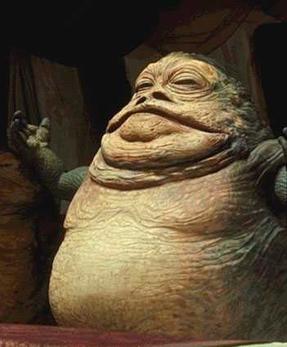
The Hutts are an alien species in the Star Wars franchise. They are rotund, voracious and grotesque-looking slug-like creatures with a predisposition to being leaders in organized crime. The most famous Hutt and the first to be depicted was Jabba the Hutt in the films Return of the Jedi, the Special Edition release of A New Hope, and The Phantom Menace. Jabba and numerous other Hutts appear in various works of the Star Wars expanded universe, which greatly elaborates on their history, culture and role in galactic society.
The Star Wars prequel trilogy, colloquially referred to as the prequels, is a series of epic space-opera films written and directed by George Lucas. It was produced by Lucasfilm Ltd. and distributed by 20th Century Fox. The trilogy was released from 1999 to 2005 and is set before the original Star Wars trilogy (1977–1983), chronologically making it the first act of the Skywalker Saga. Lucas had planned a prequel trilogy before the release of the original film, but halted major Star Wars films beyond the original trilogy by 1981. When computer-generated imagery (CGI) had advanced to the level he wanted for the visual effects he wanted for subsequent films, Lucas revived plans for the prequels by the early 1990s. The trilogy marked Lucas's return to directing after a 22-year hiatus following the original Star Wars film in 1977, as well as a 16-year hiatus between the classic and prequel trilogies.

The Star Wars Episode I: The Phantom Menace novelization was written by Terry Brooks and published on April 21, 1999, by Del Rey. It is based on the script of the film of the same name and released with multiple covers, including Darth Maul, Obi-Wan Kenobi, Anakin Skywalker and Queen Amidala.

Star Wars Episode I: The Phantom Menace – Original Motion Picture Soundtrack is the film score to the 1999 film of the same name, composed and conducted by John Williams, and performed by the London Symphony Orchestra, London Voices and the New London Children's Choir with orchestrations provided by Conrad Pope and John Neufeld. The soundtrack album was released by Sony Classical Records on May 4, 1999, two weeks before the film's theatrical release. In anticipation of the long-awaited film, the soundtrack was certified Platinum in the United States where it debuted and peaked on the Billboard 200 at number 3, and certified Gold in the United Kingdom, where it entered the UK album charts at number eight.

Star Wars: Episode I – The Phantom Menace is a 1999 action-adventure video game released by LucasArts and is an adaptation of film of the same title. The game is set in several different settings seen within the film, and takes place during the timeline of the film, with players taking on the role of Qui-Gon Jinn, Obi-Wan Kenobi, and several other characters from the film. Each playable character has a unique weapon and ability. The game features open environments to explore at the player's leisure, and dozens of non-player characters with unique dialog.

Star Wars: Racer Arcade is a 2000 arcade racing game developed by AM5 and LucasArts and is the final Star Wars game released by Sega. It is based on the Podrace scenes in the 1999 film Star Wars: Episode I – The Phantom Menace.
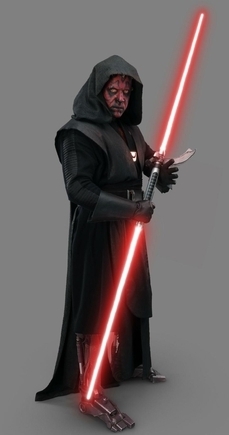
Darth Maul, later known simply as Maul, is a character in the Star Wars franchise. He first appeared in the 1999 film Star Wars: Episode I – The Phantom Menace as a powerful Sith Lord and Darth Sidious' first apprentice. Though seemingly killed by Obi-Wan Kenobi at the end of the film, Darth Maul returned in the 2008 animated series Star Wars: The Clone Wars. Star Wars creator George Lucas had intended for the resurrected Maul to serve as the main antagonist of the sequel film trilogy, but these plans were abandoned when Disney acquired Lucasfilm in 2012. The character nonetheless reappeared in the 2014 animated series Star Wars Rebels and the 2018 film Solo: A Star Wars Story, voiced again by Witwer; Park physically reprised the role in Solo. Since his initial defeat in The Phantom Menace, Maul has become an independent criminal mastermind and endured as Obi-Wan's archenemy.
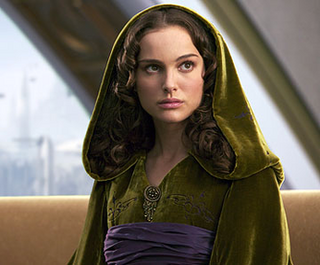
Padmé Amidala is a fictional character in the Star Wars franchise, appearing in the prequel trilogy and portrayed by Natalie Portman. First indirectly mentioned in Return of the Jedi, she is introduced in The Phantom Menace as the teenage Queen of Naboo, and after her reign, becomes a senator and an anti-war activist in the Galactic Senate. She secretly marries Anakin Skywalker, a Jedi Knight, then later dies while giving birth to twins Luke Skywalker and Leia Organa. Anakin's fear of losing Padmé serves as the catalyst in driving him to the dark side of the Force and becoming Darth Vader.



















